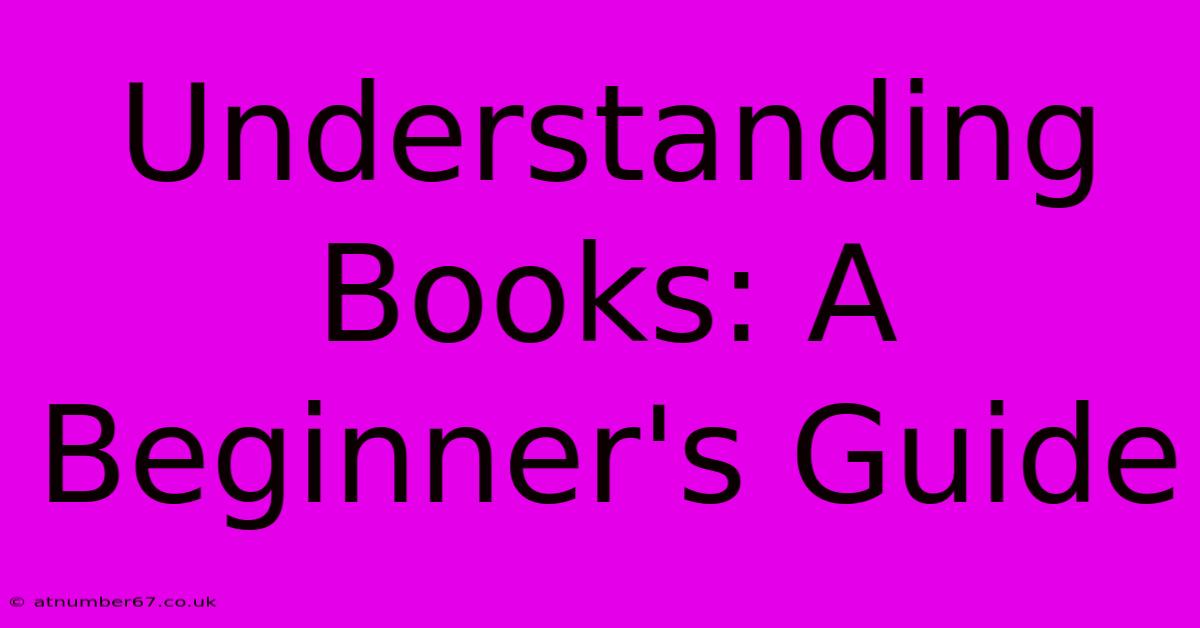Understanding Books: A Beginner's Guide

Table of Contents
Understanding Books: A Beginner's Guide
So, you want to understand books better? Whether you're a reluctant reader looking to improve your comprehension or a seasoned bookworm wanting to deepen your appreciation, this guide is for you. We'll explore the fundamental elements of books, providing you with the tools to navigate the world of literature with confidence and enjoyment.
Deconstructing the Book: Key Elements
Before diving into the narrative, let's examine the building blocks of a book. Understanding these components will significantly enhance your reading experience.
1. The Plot: The Heart of the Story
The plot is the sequence of events in a story. It usually involves:
- Exposition: The introduction of characters, setting, and initial conflict.
- Rising Action: The development of the conflict, building suspense and tension.
- Climax: The turning point of the story, where the conflict reaches its peak.
- Falling Action: The events following the climax, leading to the resolution.
- Resolution: The conclusion of the story, where loose ends are tied up.
Understanding the plot structure will help you anticipate the narrative's trajectory and better appreciate the author's choices.
2. Characters: The Driving Force
Characters are the individuals who populate the story. Pay attention to:
- Protagonist: The main character, often the hero or heroine.
- Antagonist: The character who opposes the protagonist.
- Supporting Characters: Characters who play smaller roles but contribute to the narrative.
Analyzing characters' motivations, relationships, and development will make the story more engaging. Ask yourself: Why do they act the way they do? How do their actions affect the plot?
3. Setting: More Than Just a Backdrop
The setting encompasses the time and place of the story. It's more than just a backdrop; it significantly impacts the characters and plot. Consider:
- Time Period: Is the story set in the past, present, or future?
- Geographical Location: Where does the story take place?
- Social Context: What are the social norms and cultural values of the setting?
A strong setting enriches the story, adding depth and realism.
4. Theme: The Underlying Message
The theme is the central idea or message the author wants to convey. It's often implied rather than explicitly stated. Common themes include love, loss, betrayal, redemption, and social injustice. Identifying the theme helps you understand the story's deeper meaning and significance.
5. Style and Tone: The Author's Voice
Every author has a unique writing style and tone. Style refers to the author's choice of words, sentence structure, and overall writing technique. Tone refers to the author's attitude towards the subject matter (e.g., humorous, serious, sarcastic). Recognizing the author's style and tone enhances your understanding and appreciation of their work.
Improving Your Comprehension: Practical Tips
- Active Reading: Engage actively with the text. Take notes, highlight key passages, and ask yourself questions as you read.
- Vocabulary Building: Expand your vocabulary to improve your understanding of complex words and phrases.
- Summarizing: Regularly summarize what you've read to check your comprehension and reinforce your understanding.
- Read Regularly: Consistent reading improves your reading speed and comprehension skills.
- Seek Diverse Genres: Explore different genres to broaden your literary horizons and discover new authors and styles.
Beyond the Page: Enhancing Your Reading Experience
- Join a Book Club: Discussing books with others can deepen your understanding and offer new perspectives.
- Attend Literary Events: Hear authors speak about their work and connect with fellow book lovers.
- Explore Literary Criticism: Reading critical analyses of books can offer valuable insights into the text's meaning and significance.
Understanding books is a journey, not a destination. By focusing on these key elements and employing these practical tips, you can unlock a world of literary enjoyment and enrich your life through the power of reading. Happy reading!

Thank you for visiting our website wich cover about Understanding Books: A Beginner's Guide. We hope the information provided has been useful to you. Feel free to contact us if you have any questions or need further assistance. See you next time and dont miss to bookmark.
Featured Posts
-
Michael Polansky Age And Success The Connection
Apr 03, 2025
-
Beyond The Runway Heart Evangelistas Net Worth
Apr 03, 2025
-
Mark Tilburys Net Worth Beyond The Public Eye
Apr 03, 2025
-
Alevilere Hakaret A Story Of Resilience
Apr 03, 2025
-
Frederic Arnaults Ascent To Billionaire Status
Apr 03, 2025
